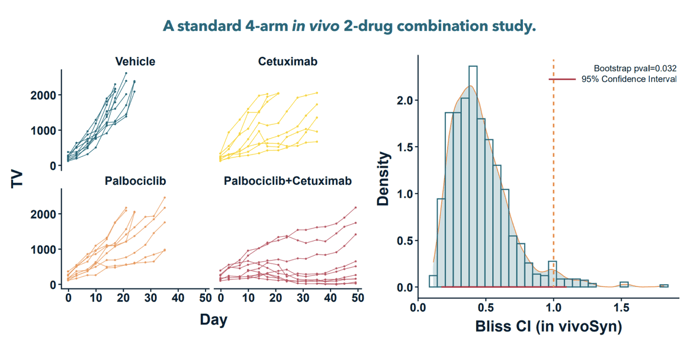- Our Services
- Platforms
- Target Solutions
- Technologies
- Service Types
- Our Science
- About Us
- Contact us

In the intricate landscape of oncology, our unyielding pursuit for innovative solutions against cancer has spotlighted a promising area: drug synergy. This concept has rapidly come to the forefront and is now a central and pivotal focus in cutting-edge cancer research.
 Cancer is not a singular disease but a myriad of ailments with complex gene and molecular interactions. While a single drug might target one specific pathway, cancer can adapt by leveraging other untargeted pathways, leading to drug resistance. This brings drug combinations into the limelight, which can offer multiple advantages:
Cancer is not a singular disease but a myriad of ailments with complex gene and molecular interactions. While a single drug might target one specific pathway, cancer can adapt by leveraging other untargeted pathways, leading to drug resistance. This brings drug combinations into the limelight, which can offer multiple advantages:
The allure of drug combinations is undeniable in the realm of medical research. Discerning which combinations truly synergize, however, has posed significant challenges. Traditionally, the synergy between drugs was explored using advanced statistical methods in standard cell lines. These in vitro studies are invaluable, providing preliminary insights into potential drug interactions before advancing to animal or human trials.
Recently, the advent of organoid technology has revolutionized these studies. Organoids offer a more complex and human-relevant model. By assessing drug combinations in these organoids, scientists can observe not just the interactions at a cellular level, but also how these drugs affect a more tissue-like structure. Incorporating organoids into drug synergy studies allows for a deeper understanding of drug interactions, potential toxicities, and effectiveness. The utilization of organoids in assessing drug combinations underscores a significant leap in in vitro studies, promising more reliable and human-relevant data in the pursuit of effective therapeutic strategies.
Drug Combination can also be evaluated on organoid models. This innovative approach allows for a more comprehensive understanding of how drugs interact within a more accurate representation of human tissue.
Click to explore how organoids are transforming drug combination studies.
Translating these findings to animal models has its own set of hurdles. Previous in vivo drug synergy studies often lacked rigorous statistical tools, which could lead to false positives. The ramifications of such inaccuracies are grave: combinations that seem promising in animal models could flounder in clinical trials.
Our publication in Cancer Research Communications heralds a transformative approach. We've introduced a method that meticulously and reliably detects drug synergy in various models. This technique is unprecedented, analyzing synergy directly from tumor volume data without making undue assumptions about tumor growth dynamics. With the advent of the invivoSyn framework, we're equipped with a potent tool to scrutinize drug synergy in vivo. Its insights, grounded in robust statistical methodologies, will play an instrumental role in shaping the trajectory of combination therapy studies. As drug synergy continues to occupy a pivotal position in therapeutic stratagems, especially in oncology, tools like invivoSyn will be indispensable. We're eager to further expand its capabilities, ensuring it aligns with an even broader array of datasets.
Delving deeper into this promising arena, Crown Bioscience offers CrownSyn – a dedicated service for both in vitro and in vivo studies.
With the CrownSyn service, seamlessly evaluate and quantify the effects of two-drug combinations—be it synergistic, antagonistic, or additive—in both in vitro and in vivo assays. You can use data from your existing assays, or collaborate with our experts to design a study. Benefit from our diverse range of assay options and our rigorously validated in vitro and in vivo models.
Adapting to various experimental designs, including fixed ratio and matrix designs.
From dose-response curves to 3D response surface plots, our platform paints a comprehensive picture of drug interactions.
Tried and tested in numerous studies, CrownSyn guarantees data integrity and reliability.


© 2024 Crown Bioscience. All Rights Reserved.


© 2024 Crown Bioscience. All Rights Reserved. Privacy Policy
2024-12-12
2021-10-21
site_page